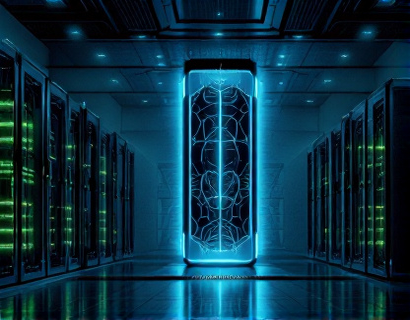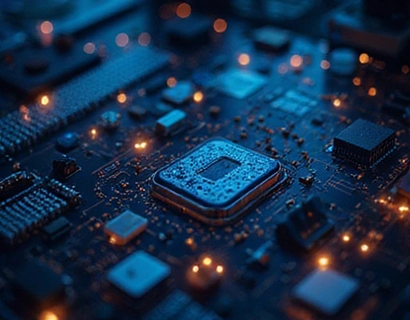Blockchain-Powered Registry Management: Enhancing Data Integrity and Trust with Advanced Software Solutions
In the digital age, the management of registries has become a critical aspect of various industries, including government, finance, healthcare, and more. Traditional registry management systems often face challenges such as data breaches, lack of transparency, and inefficiencies in data handling. The advent of blockchain technology offers a revolutionary approach to address these issues, providing unparalleled security, transparency, and efficiency. This article delves into how blockchain-enabled software solutions can transform registry management, ensuring data integrity and building trust among professionals in data management, security, and digital transformation.
Understanding Blockchain Technology
Before exploring its application in registry management, it's essential to understand the fundamentals of blockchain technology. Blockchain is a decentralized digital ledger that records transactions across multiple computers in such a way that the registered transactions cannot be altered retroactively. Each block in the chain contains a cryptographic hash of the previous block, a timestamp, and transaction data. This structure ensures that once data is recorded, it is immutable and transparent, making it highly secure against tampering and fraud.
Challenges in Traditional Registry Management
Traditional registry management systems often rely on centralized databases, which are vulnerable to various risks. Centralized systems are prime targets for cyberattacks, leading to data breaches and loss of sensitive information. Moreover, these systems lack transparency, making it difficult to track changes and ensure accountability. The centralized nature also introduces single points of failure, where a single breach can compromise the entire system. Additionally, the manual processes involved in traditional registry management are time-consuming and prone to human errors, leading to inefficiencies and increased operational costs.
Blockchain in Registry Management: Key Benefits
The integration of blockchain technology in registry management addresses many of the challenges faced by traditional systems. Here are some key benefits:
- Enhanced Security: The immutable nature of blockchain ensures that once data is recorded, it cannot be altered or deleted. This provides a high level of security against data tampering and fraud.
- Transparency: All transactions are recorded on a public ledger, making it easy to track changes and verify the authenticity of data. This transparency builds trust among stakeholders.
- Efficiency: Automated smart contracts can streamline processes, reducing the need for manual interventions and speeding up operations. This leads to faster processing times and lower operational costs.
- Data Integrity: The decentralized and consensus-based nature of blockchain ensures that data remains consistent and accurate across all nodes in the network.
Implementing Blockchain for Registry Management
Implementing blockchain for registry management involves several steps, from selecting the right blockchain platform to integrating it with existing systems. Here’s a high-level overview of the process:
First, organizations need to choose a suitable blockchain platform. Options range from public blockchains like Ethereum and Hyperledger Fabric to private blockchains tailored for specific use cases. The choice depends on factors such as scalability, privacy requirements, and the level of control needed.
Once the platform is selected, the next step is to design the blockchain architecture. This includes defining the structure of the blocks, the consensus mechanism, and the permissions for different stakeholders. For registry management, a permissioned blockchain is often preferred to control access and ensure data privacy.
After setting up the blockchain infrastructure, the next phase involves integrating the registry data into the blockchain. This requires mapping existing data models to the blockchain format and developing interfaces to facilitate data transfer. Smart contracts can be programmed to automate specific tasks, such as verifying identities, updating records, and triggering notifications.
Testing is a crucial step to ensure the system works as intended. Organizations should conduct thorough testing, including unit tests, integration tests, and real-world scenarios to identify and rectify any issues. Once the system is validated, it can be deployed in a controlled environment before a full-scale rollout.
Case Studies and Real-World Applications
Several organizations across different sectors have successfully implemented blockchain for registry management, demonstrating the technology's potential. Here are a few notable examples:
In the government sector, Estonia has been a pioneer in using blockchain for various public services, including land registry management. The Estonian Land Registry uses a blockchain-based system to ensure secure and transparent property transactions. This has significantly reduced the risk of fraud and streamlined the process for both citizens and businesses.
In the financial industry, JPMorgan Chase has developed an internal blockchain platform called Interbank Information Network (IIN). While not a traditional registry, IIN uses blockchain to share transaction data among banks, enhancing transparency and reducing the risk of errors and fraud in trade finance processes.
In healthcare, the Medibloc platform uses blockchain to manage patient records and medical data. This ensures that patient data is secure, private, and easily accessible to authorized parties, improving the overall quality of care and patient trust.
Challenges and Considerations
While the benefits of blockchain in registry management are clear, there are several challenges and considerations that organizations must address:
First, the technology is still relatively new, and there is a learning curve associated with implementing and managing blockchain systems. Organizations need to invest in training and development to build the necessary expertise.
Scalability is another concern, especially for public blockchains that may face performance issues with a large volume of transactions. Private blockchains can offer better scalability but require careful design to balance security and performance.
Regulatory compliance is also a critical factor. Different regions have varying regulations regarding data privacy and security, and organizations must ensure their blockchain solutions comply with local laws. This may involve working closely with regulatory bodies to navigate the legal landscape.
Finally, interoperability between different blockchain systems and existing legacy systems can be challenging. Organizations need to develop strategies to ensure seamless integration and data exchange.
Future Trends and Innovations
The intersection of blockchain and registry management is an evolving field, with ongoing research and development leading to new innovations. Some future trends include:
1. Interoperability Standards: The development of standardized protocols will facilitate better integration between different blockchain systems and traditional databases, enhancing the overall ecosystem.
2. Self-Sovereign Identity: Blockchain-based identity management systems will empower individuals to control their own digital identities, reducing reliance on centralized authorities and enhancing privacy.
3. Decentralized Autonomous Organizations (DAOs): DAOs can leverage blockchain to manage registry data and decision-making processes in a transparent and decentralized manner, revolutionizing governance structures.
4. Quantum Resistance: As quantum computing advances, there will be a greater focus on developing blockchain algorithms that are resistant to quantum attacks, ensuring long-term security.
Conclusion
Blockchain-powered registry management offers a transformative solution to the challenges faced by traditional systems. By ensuring data integrity, enhancing security, and improving efficiency, blockchain technology can build trust and streamline processes across various industries. While there are challenges to overcome, the potential benefits make it a compelling choice for organizations looking to modernize their registry management practices. As the technology continues to evolve, we can expect even more innovative applications and broader adoption in the future.










































